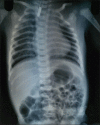Thirteen ribs and long gap oesophageal atresia: The embryological hypothesis for exploration
- PMID: 33342843
- PMCID: PMC8051636
- DOI: 10.4103/ajps.AJPS_72_19
Thirteen ribs and long gap oesophageal atresia: The embryological hypothesis for exploration
Abstract
Context: Since the gap between two atretic segments of oesophagus is a critical determinant of prognosis for oesophageal atresia/tracheoesophageal fistula (EA/TEF), the search for a surrogate non-invasive pre-operative marker of long gap atresia continues.
Aims: The purpose of the study was to compare the presence of normal and supernumerary ribs with length of EA and survival rates.
Settings and design: A prospective observational study was conducted at a tertiary care referral neonatal intensive care unit in North Karnataka, India, from January 2016 to June 2019.
Subjects and methods: Amongst babies with EA/TEF, pre-operative radiograph helped determine the number of ribs, and babies were divided into two groups; Group I: babies with 12 ribs and Group II: babies with supernumerary ribs.
Statistical analysis used: Nominal variables were expressed as percentage and continuous variables as mean standard deviation. MedCalc software was used to compare proportions and means. A P < 0.05 was considered statistically significant.
Results: Of the 61 cases, 51 were operated. Long gap EA was predominantly seen amongst babies in Group II (40% in Group II vs. 27% in Group I, P= 0.424). Survival rates by percentage were lower in babies in Group II (60% in Group II vs. 80% in Group I, P= 0.188). Both the above findings were proven statistically insignificant. The overall survival rate amongst the study population was 78.4% (39/51).
Conclusions: Supernumerary ribs were associated with a higher occurrence of long gap EA and lower survival rates, though statistically insignificant. Multicentre collaboration may provide significant input for strengthening or refuting the above hypothesis.
Keywords: Fistula; long gap oesophageal atresia; supernumerary ribs; thirteen ribs; tracheoesophageal.
Conflict of interest statement
None
Figures



Similar articles
-
13 ribs as a predictor of long gap esophageal atresia: myth or reality? Analysis of associated findings of esophageal atresia and abnormal rib count.J Pediatr Surg. 2017 Aug;52(8):1252-1254. doi: 10.1016/j.jpedsurg.2017.04.019. Epub 2017 May 2. J Pediatr Surg. 2017. PMID: 28545763
-
13 pairs of ribs--a predictor of long gap atresia in tracheoesophageal fistula.J Pediatr Surg. 1997 Oct;32(10):1453-4. doi: 10.1016/s0022-3468(97)90560-1. J Pediatr Surg. 1997. PMID: 9349767
-
Association between long gap atresia and 13 ribs in neonates presenting with esophageal atresia and tracheoesophageal fistula.J Pediatr Surg. 1998 Aug;33(8):1328. doi: 10.1016/s0022-3468(98)90184-1. J Pediatr Surg. 1998. PMID: 9722019 No abstract available.
-
Current knowledge on esophageal atresia.World J Gastroenterol. 2012 Jul 28;18(28):3662-72. doi: 10.3748/wjg.v18.i28.3662. World J Gastroenterol. 2012. PMID: 22851858 Free PMC article. Review.
-
Basic Knowledge of Tracheoesophageal Fistula and Esophageal Atresia.Adv Neonatal Care. 2018 Feb;18(1):14-21. doi: 10.1097/ANC.0000000000000464. Adv Neonatal Care. 2018. PMID: 29373345 Review.
References
-
- Kulkarni B, Rao RS, Oak S, Upadhyaya MA. 13 pairs of ribs-A predictor of long gap atresia in tracheoesophageal fistula. J Pediatr Surg. 1997;32:1453–4. - PubMed
-
- Al-Shanafey S, Harvey J. Long gap esophageal atresia: An Australian experience. J Pediatr Surg. 2008;43:597–601. - PubMed
-
- [[Last accessed on 2019 Mar 24]]. Available from: https://clinicaltrials.gov/ct2/show/NCT03023865 .
-
- Bosenberg AT, Hadley GP. Association between long gap atresia and 13 ribs in neonates presenting with esophageal atresia and tracheoesophageal fistula. J Pediatr Surg. 1998;33:1328. - PubMed
-
- Durell J, Dagash H, Eradi B, Rajimwale A, Nour S, Patwardhan N. 13 ribs as a predictor of long gap esophageal atresia: Myth or reality.Analysis of associated findings of esophageal atresia and abnormal rib count? J Pediatr Surg. 2017;52:1252–4. - PubMed
Publication types
MeSH terms
LinkOut - more resources
Full Text Sources
Miscellaneous
